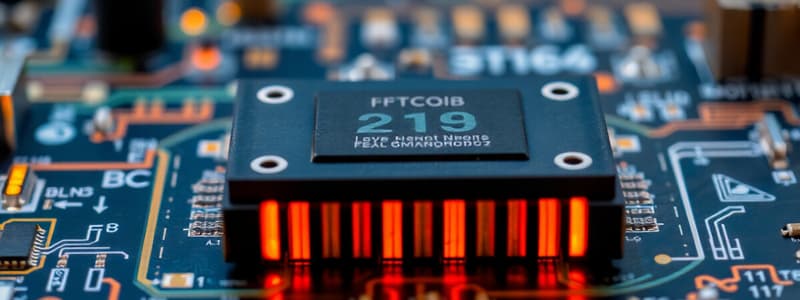Podcast
Questions and Answers
What does the term VTO represent in the threshold voltage equations?
What does the term VTO represent in the threshold voltage equations?
- Body-effect coefficient
- Generalized threshold voltage
- Zero substrate bias threshold voltage (correct)
- Depletion charge density
How does the presence of nonzero substrate bias affect the threshold voltage expression?
How does the presence of nonzero substrate bias affect the threshold voltage expression?
- It adds a term related to source-to-substrate voltage. (correct)
- It replaces all terms in the equation.
- It has no effect on the threshold voltage.
- It reduces the threshold voltage to zero.
In the expression for threshold voltage VT, what does the parameter y represent?
In the expression for threshold voltage VT, what does the parameter y represent?
- Threshold voltage under zero bias
- Substrate-bias coefficient (correct)
- Voltage due to charge density
- Capacitance per unit area
Which statement is true about the generalized threshold voltage expression?
Which statement is true about the generalized threshold voltage expression?
What is the additive term that distinguishes the threshold voltage from VTO in the generalized expression?
What is the additive term that distinguishes the threshold voltage from VTO in the generalized expression?
Which equation represents the greatest generalization of the threshold voltage VT?
Which equation represents the greatest generalization of the threshold voltage VT?
Which term in the threshold voltage expression is influenced by substrate voltage VSB?
Which term in the threshold voltage expression is influenced by substrate voltage VSB?
What effect does the parameter NA have on the threshold voltage expression?
What effect does the parameter NA have on the threshold voltage expression?
What type of semiconductor is the substrate in an n-channel MOSFET?
What type of semiconductor is the substrate in an n-channel MOSFET?
What is the characteristic of the depletion region charge densities in an n-channel MOSFET?
What is the characteristic of the depletion region charge densities in an n-channel MOSFET?
What is the typical threshold voltage of an enhancement-type n-channel MOSFET?
What is the typical threshold voltage of an enhancement-type n-channel MOSFET?
What is the expected relationship of the substrate bias voltage VSB in an n-channel MOSFET?
What is the expected relationship of the substrate bias voltage VSB in an n-channel MOSFET?
How is the Fermi potential of the polysilicon gate described in this context?
How is the Fermi potential of the polysilicon gate described in this context?
Calculating the work function difference cOGC results in which of the following values?
Calculating the work function difference cOGC results in which of the following values?
What is the gate oxide capacitance per unit area calculated from the given dielectric constant and oxide thickness?
What is the gate oxide capacitance per unit area calculated from the given dielectric constant and oxide thickness?
What is the result of combining the components to calculate the threshold voltage?
What is the result of combining the components to calculate the threshold voltage?
What effect is described as being unavoidable in most digital circuits?
What effect is described as being unavoidable in most digital circuits?
In an nMOS transistor, what is the initial state of both p-n junctions?
In an nMOS transistor, what is the initial state of both p-n junctions?
Which terminal potential must be lower than the other terminals to maintain reverse-bias in an nMOS transistor?
Which terminal potential must be lower than the other terminals to maintain reverse-bias in an nMOS transistor?
What happens to the mid-gap energy level at the surface when the gate voltage exceeds the threshold voltage?
What happens to the mid-gap energy level at the surface when the gate voltage exceeds the threshold voltage?
What forms between the source and the drain once the inversion layer is established?
What forms between the source and the drain once the inversion layer is established?
What is necessary for the surface of a MOS transistor to be considered inverted?
What is necessary for the surface of a MOS transistor to be considered inverted?
What is required for carrier flow to occur in the channel of an nMOS transistor?
What is required for carrier flow to occur in the channel of an nMOS transistor?
What happens to the mobile electron concentration on the surface of a MOS transistor when the gate voltage is increased beyond the point of surface inversion?
What happens to the mobile electron concentration on the surface of a MOS transistor when the gate voltage is increased beyond the point of surface inversion?
What is the impact of achieving surface inversion on the depletion region depth in a MOS transistor?
What is the impact of achieving surface inversion on the depletion region depth in a MOS transistor?
What is the main function of the gate in an nMOS transistor?
What is the main function of the gate in an nMOS transistor?
What must circuit designers do to address threshold voltage variations?
What must circuit designers do to address threshold voltage variations?
Which material is used as the semiconductor in the MOS transistor structure described?
Which material is used as the semiconductor in the MOS transistor structure described?
What phenomenon is essential for current conduction in MOS transistors?
What phenomenon is essential for current conduction in MOS transistors?
How does the Fermi potential in the surface layer relate to the bulk Fermi potential once the surface inversion occurs?
How does the Fermi potential in the surface layer relate to the bulk Fermi potential once the surface inversion occurs?
What determines the maximum depletion region depth at the onset of surface inversion in a MOS transistor?
What determines the maximum depletion region depth at the onset of surface inversion in a MOS transistor?
What effect does removing the external gate bias have on the conducting surface inversion layer?
What effect does removing the external gate bias have on the conducting surface inversion layer?
What does the depletion region charge density primarily consist of?
What does the depletion region charge density primarily consist of?
What happens to the energy bands as the positive gate bias increases?
What happens to the energy bands as the positive gate bias increases?
What condition is referred to when the mid-gap energy level becomes smaller than the Fermi level at the surface?
What condition is referred to when the mid-gap energy level becomes smaller than the Fermi level at the surface?
What dictates the depth of the depletion region?
What dictates the depth of the depletion region?
In the context of a MOS system, what is referred to as the inversion layer?
In the context of a MOS system, what is referred to as the inversion layer?
What effect does the positive gate potential have on minority carriers?
What effect does the positive gate potential have on minority carriers?
What formula is used to calculate the depth of the depletion region?
What formula is used to calculate the depth of the depletion region?
What role does the depletion region charge density play in MOS systems?
What role does the depletion region charge density play in MOS systems?
Flashcards are hidden until you start studying
Study Notes
Threshold Voltage Expressions
- For zero substrate bias, the threshold voltage ( V_{T}^O ) is defined using a specific formula incorporating various charge densities.
- Nonzero substrate bias modifies the depletion charge density term, leading to a generalized threshold voltage expression that accounts for the source-to-substrate voltage ( V_{SB} ).
- The generalized threshold voltage ( V_{T} ) can be rearranged to show an additive term influenced by material constants.
Influence of Substrate Bias
- The generalized expression shows that the threshold voltage differs from the zero-bias voltage only by the substrate-bias term.
- The substrate-bias term is derived from the material parameters and the applied voltage ( V_{SB} ).
Substrate Bias Coefficient
- The substrate-bias coefficient ( \gamma ) is defined as proportional to the charge concentration and voltage, impacting threshold voltage behavior.
- This coefficient has different signs for n-channel MOSFETs (nMOS) and p-channel MOSFETs (pMOS), reflecting the nature of the substrate material.
Characteristics of nMOS and pMOS
- For nMOS, the substrate Fermi potential is negative, while it is positive for pMOS.
- Charge densities in the depletion region differ in sign based on the type of MOSFET (negative for nMOS, positive for pMOS).
- ( V_{SB} ) is positive for nMOS and negative for pMOS, resulting in distinct threshold voltage characteristics.
Threshold Voltage Values
- Typically, enhancement-type nMOS transistors have a positive threshold voltage, whereas p-channel MOSFETs usually exhibit a negative threshold voltage.
Example Calculation of Threshold Voltage
- Example parameters: substrate doping density ( N_A = 10^{16} , \text{cm}^{-3} ), polysilicon gate doping density ( N_D = 2 \times 10^{20} , \text{cm}^{-3} ), gate oxide thickness ( t_{ox} = 500 , \text{Å} ).
- Fermi potentials for both substrate and gate calculated to assess work function difference impacting the threshold.
Physical Operation of nMOS Transistors
- nMOS transistors are structured to include a MOS capacitor and p-n junctions around the channel.
- Carriers (electrons) move from source to drain, controlled by the gate voltage applied.
- Initial conditions maintain reverse bias on the p-n junctions to prevent conduction until the threshold is exceeded.
Inversion Layer Formation
- Surface inversion occurs when gate voltage exceeds threshold, creating an n-type channel by attracting electrons.
- The condition for inversion is achieved when surface potential matches bulk Fermi potential in magnitude but opposite in polarity.
- Further increases in gate voltage lead to a stable concentration of carriers without altering depletion depth, establishing the inversion layer necessary for conduction.
Charge Behavior in the Depletion Region
- The depletion region is characterized by fixed acceptor ions that create charge densities influencing threshold voltage analysis.
- The maximum depletion region depth corresponds to the onset of surface inversion, defined by the established equations relating charge density and electric field effects near the surface.
Studying That Suits You
Use AI to generate personalized quizzes and flashcards to suit your learning preferences.




